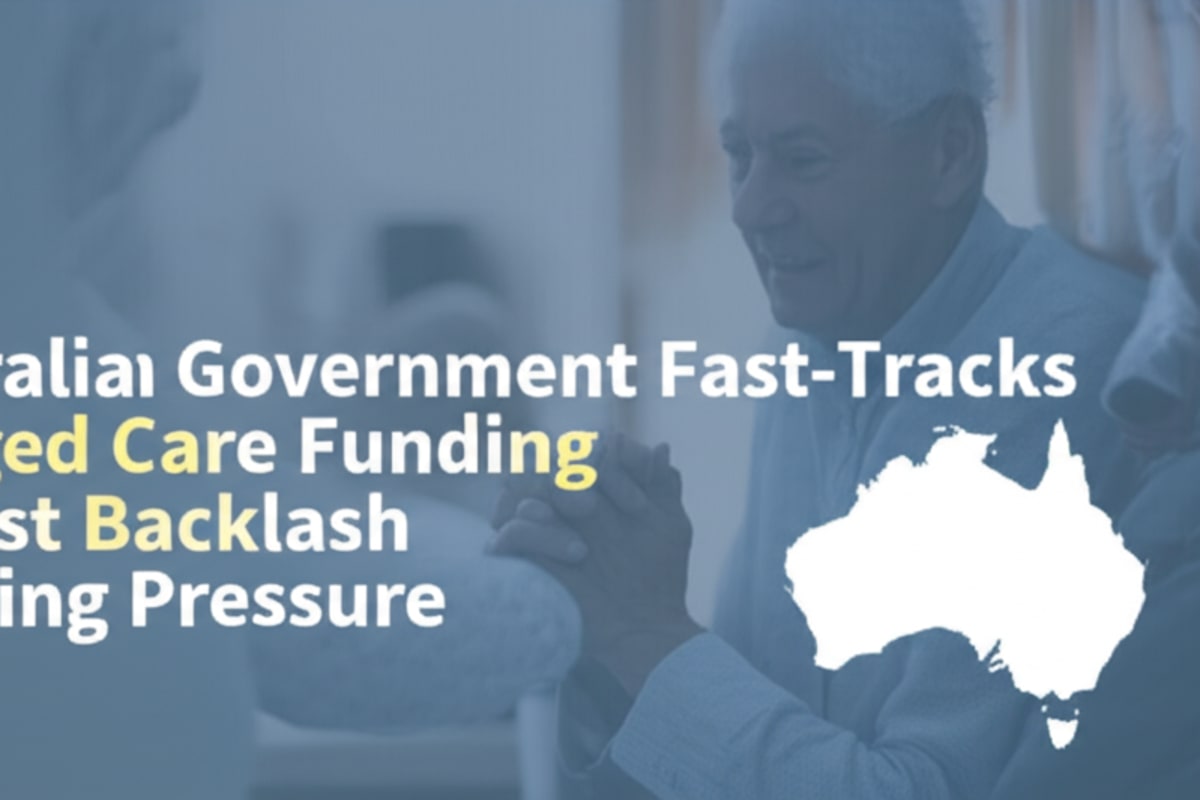Australia Speeds Up Aged Care Funding Amidst Backlash

Australian Government Fast-Tracks Aged Care Funding Amid Growing Pressure
Under mounting political pressure and widespread public concern over the nation's aging population, the Australian Labor government has announced the expedited release of funding for 20,000 in-home aged care places
Background
This decision represents a partial reversal of the government's original plan to delay the commencement of its new aged care system from July 1st, 2025, to November 1st, 2025
The announcement follows intense lobbying efforts from both the Senate crossbench and the Coalition opposition, who highlighted the plight of vulnerable Australians left waiting for crucial services
The initial delay had left an estimated 87,000 approved applicants in limbo, exposing a significant gap in the country's aged care infrastructure and sparking a wave of criticism
This backlog placed immense strain on the existing system, forcing elderly Australians and their families to navigate inadequate support, endure protracted waiting periods, and bear the emotional burden of delayed essential care
The government now aims to disburse the allocated funding within eight weeks, hoping to alleviate some of the immediate pressure on vulnerable individuals and their caregivers
The funding will be distributed through existing Home Care Package providers, with priority given to those on the highest priority waiting lists
Southeast Asian Context: Shared Challenges
The Australian situation mirrors the challenges confronting many Southeast Asian nations grappling with similar demographic shifts and evolving healthcare needs
Countries such as Singapore, Thailand, and Vietnam are actively developing and implementing comprehensive strategies to address the burgeoning demand for aged care services
Australia's experience serves as a valuable case study, illustrating the complexities of managing such a critical transition and underscoring the imperative of meticulous planning, substantial and sustained funding, and adaptable policy frameworks
Experts suggest that cross-national collaboration and the sharing of best practices could benefit all countries facing these demographic shifts
Analysis: A Band-Aid Solution or a Step in the Right Direction?
While the 20,000 new in-home care places represent a welcome injection of resources, they address only a fraction of the identified need.
The government's broader aged care reforms, slated to commence in November, are intended to usher in more comprehensive and lasting changes
These reforms include a new funding model, increased regulation, and a focus on improving the quality of care
However, concerns persist regarding their long-term viability and effectiveness.
Critics contend that the current funding boost is, at best, a temporary fix, insufficient to address the underlying systemic issues that continue to plague the aged care sector
These issues include workforce shortages, inadequate pay for caregivers, and a lack of clear accountability mechanisms
The Royal Commission into Aged Care Quality and Safety previously highlighted these systemic issues in its final report
To ensure the long-term success of its reforms, the government must demonstrate a robust and comprehensive strategy that effectively meets the evolving demands of an aging population. "This is a step in the right direction, but much more needs to be done to address the root causes of the crisis in aged care," stated Senator Sarah Hanson-Young, a vocal advocate for aged care reform. She further added that the government needs to address the systemic issues highlighted by the Royal Commission, including workforce shortages and inadequate funding.
Political Implications and Public Perception
The government's decision to expedite funding can be interpreted as a calculated maneuver to mitigate potential electoral repercussions.
The initial delay and the resultant extensive waiting list presented a significant point of vulnerability for the Labor government, particularly given the profound emotional resonance of the issue among voters
By reacting to the widespread public outcry, the government seeks to diffuse discontent and restore public trust in its ability to manage this critical area of social welfare
The opposition has been quick to criticize the government's initial handling of the situation, highlighting what they perceive as a lack of foresight and planning
They have also questioned the government's ability to effectively implement the broader aged care reforms scheduled for November
Questions Raised and Future Projections
The government's response also raises pertinent questions regarding its initial planning processes and the accuracy of its initial demand projections
The sheer magnitude of the waiting list suggests a potential underestimation of the demand for in-home aged care services, underscoring the inherent challenges of implementing large-scale social welfare programs effectively
This situation necessitates a more rigorous review of existing procedures and a more forward-looking assessment of the future needs of the aging population
Industry experts and advocacy groups are increasingly calling for more transparent data collection methodologies and sophisticated predictive models to anticipate and proactively manage future demands on the aged care system
Some specific recommendations include:
- Increased funding for training and development of aged care workers: Addressing the workforce shortage is crucial for providing quality care.
- Improved data collection and analysis: Accurate data is essential for effective planning and resource allocation.
- Greater emphasis on preventative care: Promoting healthy aging can reduce the demand for acute care services.
Conclusion: A Reactive Measure with Long-Term Implications
In conclusion, the accelerated funding allocation for 20,000 in-home aged care places represents a significant, albeit reactive, step towards addressing a critical challenge within the Australian healthcare landscape
While it provides much-needed immediate relief, the long-term effectiveness of these measures remains uncertain
The government's actions will be subject to intense scrutiny both domestically and internationally, particularly by nations confronting analogous demographic trends and healthcare challenges
The ultimate success of this policy hinges on its seamless integration with the broader aged care reforms scheduled for implementation in November and on a sustained commitment to ongoing assessment and adaptive adjustments in response to future needs
Furthermore, ongoing dialogue with stakeholders, including aged care providers, advocacy groups, and the elderly themselves, will be crucial for ensuring that the reforms are effective and responsive to the needs of the community
